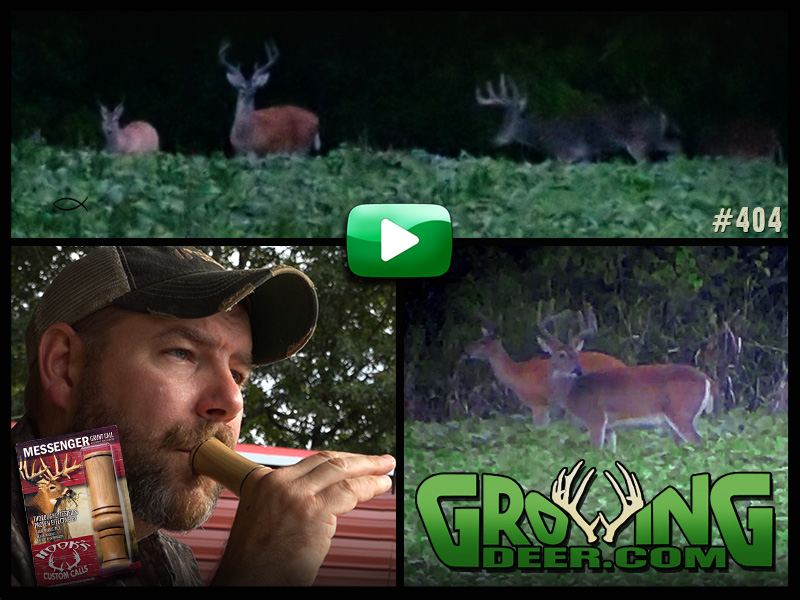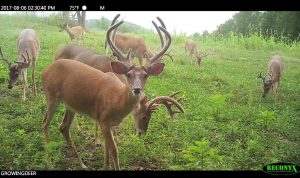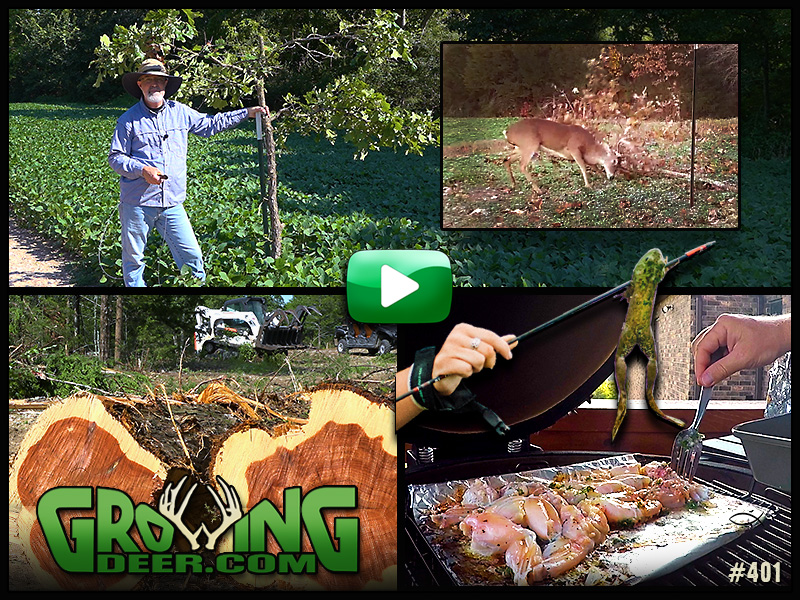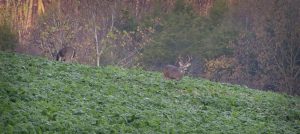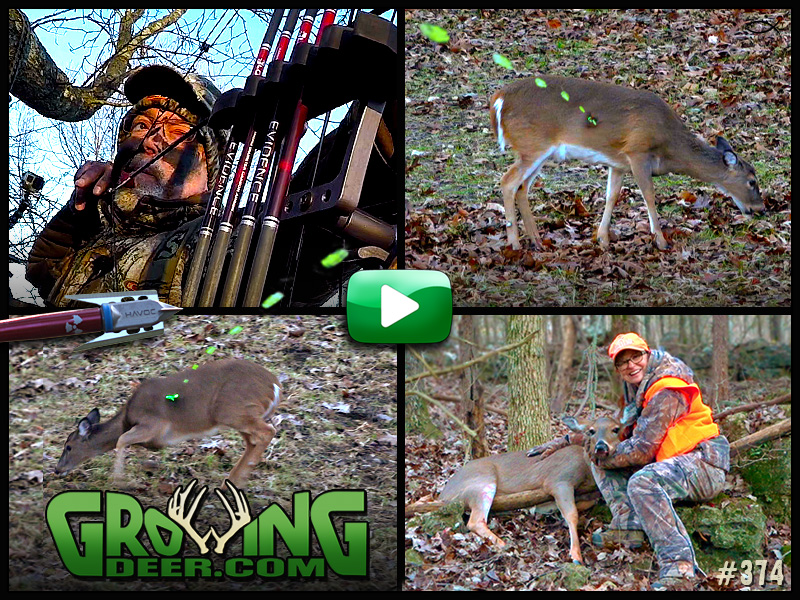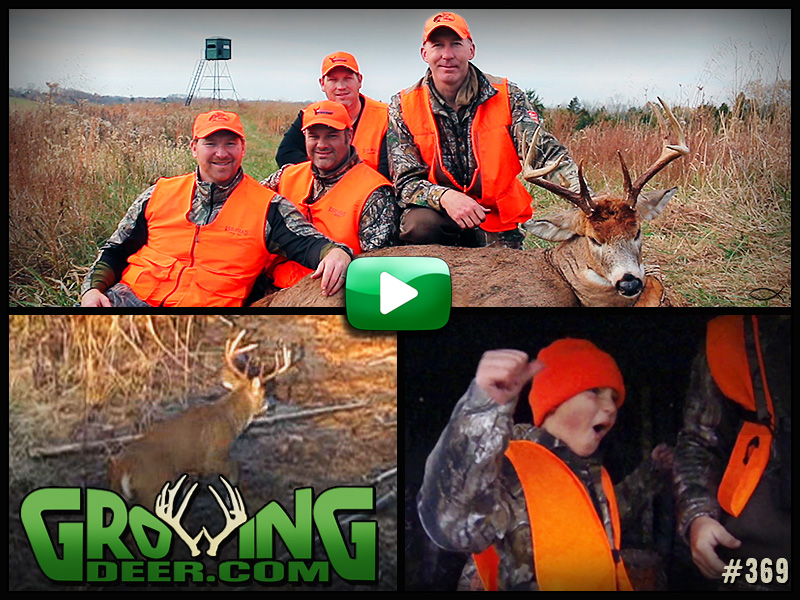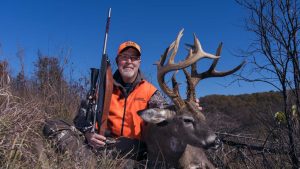Category: Deer Management
Grunt Calling! Get Tuned Up! – Episode #404
New Video
Grant and Daniel take advantage of velvet bucks feeding in soybeans and scout for hit list bucks! We catch up with James Harrison to learn more about one of our most important deer hunting tools – the grunt call! Plus, find out what new habitat projects the GrowingDeer Team have started!
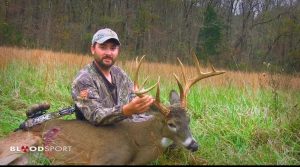 Short Clip:
Short Clip:
“Bonus” bucks are always great! Watch as Chase White grunts in a great bonus buck and punches his 2016 tag!
New Weekly Blog:
Trail camera surveys are a great tool for gathering important herd information. This can help managers/hunters better manage their herds and create hunting strategies for the upcoming season. Find out more in the blog!
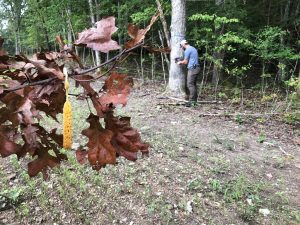
Tip of the Week:
Mock scrapes and synthetic scent can be a great way to monitor bucks on trail cameras, even during the early season!
Deer Hunters That Are The Most Satisfied Have Realistic Expectations
Folks are realizing that to hunt mature bucks, mature bucks must exist. For example, hunting mature bucks on properties where a majority of the yearling bucks are shot each year is often very frustrating.
The primary determinant of antler size is a buck’s age. Hence allowing bucks to mature before harvesting them is the most efficient method to produce large antlers. Providing good quality habitat allows bucks to produce larger antlers at an earlier age.
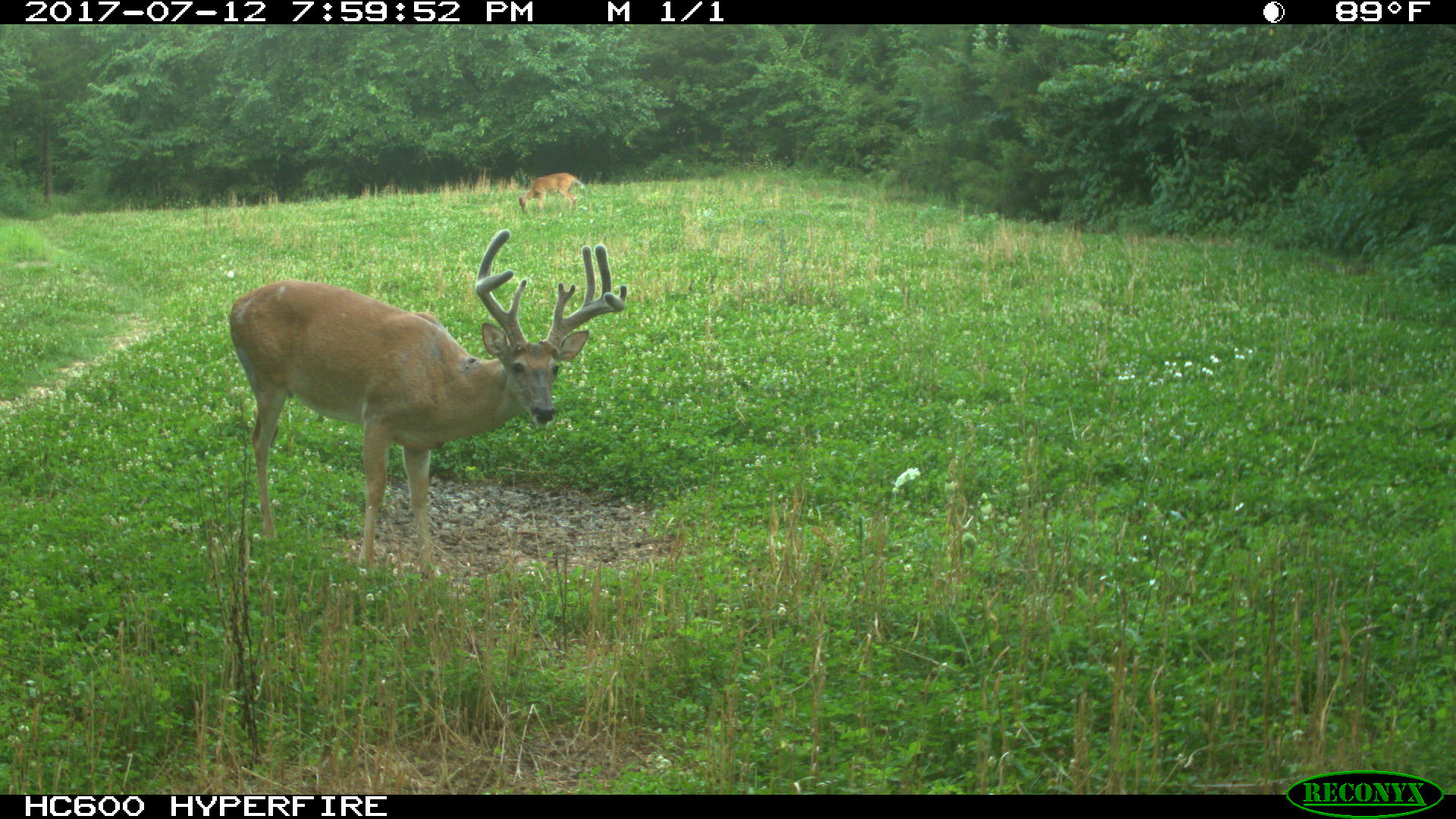
To produce mature bucks year after year there needs to be trigger finger management and quality forage.
The more mature bucks in the area the better the odds of having an encounter. A higher percentage of the total buck harvest is usually composed of mature bucks in states with a more restrictive bag limit for bucks. Kentucky and Kansas are good examples of states with a restrictive buck bag limit and a trend of producing great mature bucks annually.
This is just a trend. I’m aware of individual properties in most states that produce great mature bucks. These landowners or deer management cooperatives usually establish more favorable deer harvest guidelines than imposed by the state’s regulations.
Simply allowing bucks to reach maturity doesn’t mean they will express their full antler growth potential. Bucks need an excellent source of nutrition throughout their life to express their full antler growth potential – in addition to living to maturity. Even further, the health (good food, limited stress) of the buck’s mother has an impact on the buck’s health and his ability to express his genetic potential.
This means that simply increasing the quality of a buck’s diet for a year or two won’t necessarily allow him to express his full potential. The overall health of a buck (or other critter) is substantially impacted by their development years. When Tracy and I purchased The Proving Grounds, it was a horribly overgrazed cattle ranch. We’ve now owned it for 15 years and spent a lot of time and resources improving the habitat. Through the years, we’ve seen a substantial improvement in antler and body size of bucks that have been provided nutritious forage options.
This process can take much less time if the property is in an area where quality nutrition has never been a limiting factor and the only missing piece of the deer management puzzle is allowing bucks to reach maturity. In other words, the lower the quality of habitat, the longer it will take to allow the herd to express its full potential. However, such land usually costs much less than row crop land where good nutrition has been available year-round for many years.
I really enjoy the process of managing and hunting for mature bucks. I like going on suitcase hunts – hunting properties that I show up for a week or so a year and my only management activity is deciding to pass or pull the trigger. However, my passion is growing and hunting mature bucks. If you share my passion, we’ll keep learning together.
Enjoy Creation,
Grant
Cooking Frog Legs | Converting Pasture | Creating Mock Scrapes – Episode #401
New Video
The GrowingDeer Team fixes a mess of frog legs! After a great meal, Grant heads to the field with the interns and begins converting an old pasture overgrown by cedars into a quality wildlife food source. Plus, we share how to make and use mock scrapes during the late summer!
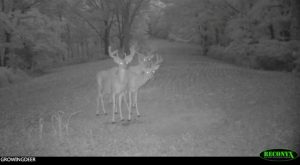 Short Clip:
Short Clip:
Three great looking velvet bucks can’t help but show off their stuff! Watch “The Three Amigos” pose for a great video!
New Weekly Blog:
Find out how deer use thermals or air movement based on slope and temperature to alert them of predators (two and four legged). Knowing how deer use thermals will help you know where, when and how to hunt this fall!
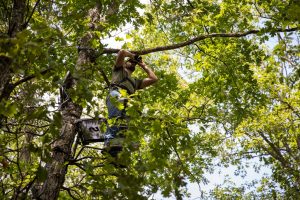
Tip of the Week:
Acorn crops can differ year to year. While trimming or hanging stands, check for this year’s acorn crop and hunt accordingly.
Why The Best Deer Hunting Is On Flat Ground
I’ve been discussing how to manage land to produce mature and huntable bucks. It’s relatively easy to produce mature bucks. Simply don’t harvest them until they are 4+ years of age. I define mature for whitetail bucks as being four years old or older because by that age most bucks have expressed 90+ percent of their antler growth potential.
In previous blogs, I’ve also discussed management strategies which allow bucks to express their antler growth potential. Just because a buck is allowed to live until he is 4+ years of age doesn’t mean he will produce antlers to his full genetic potential. If he hasn’t had access to a quality diet and experienced minimal stress, he will not produce antlers to his full genetic potential.
After discussing several aspects of managing deer so they can express their full genetic potential, I’d like to discuss how to harvest mature bucks.
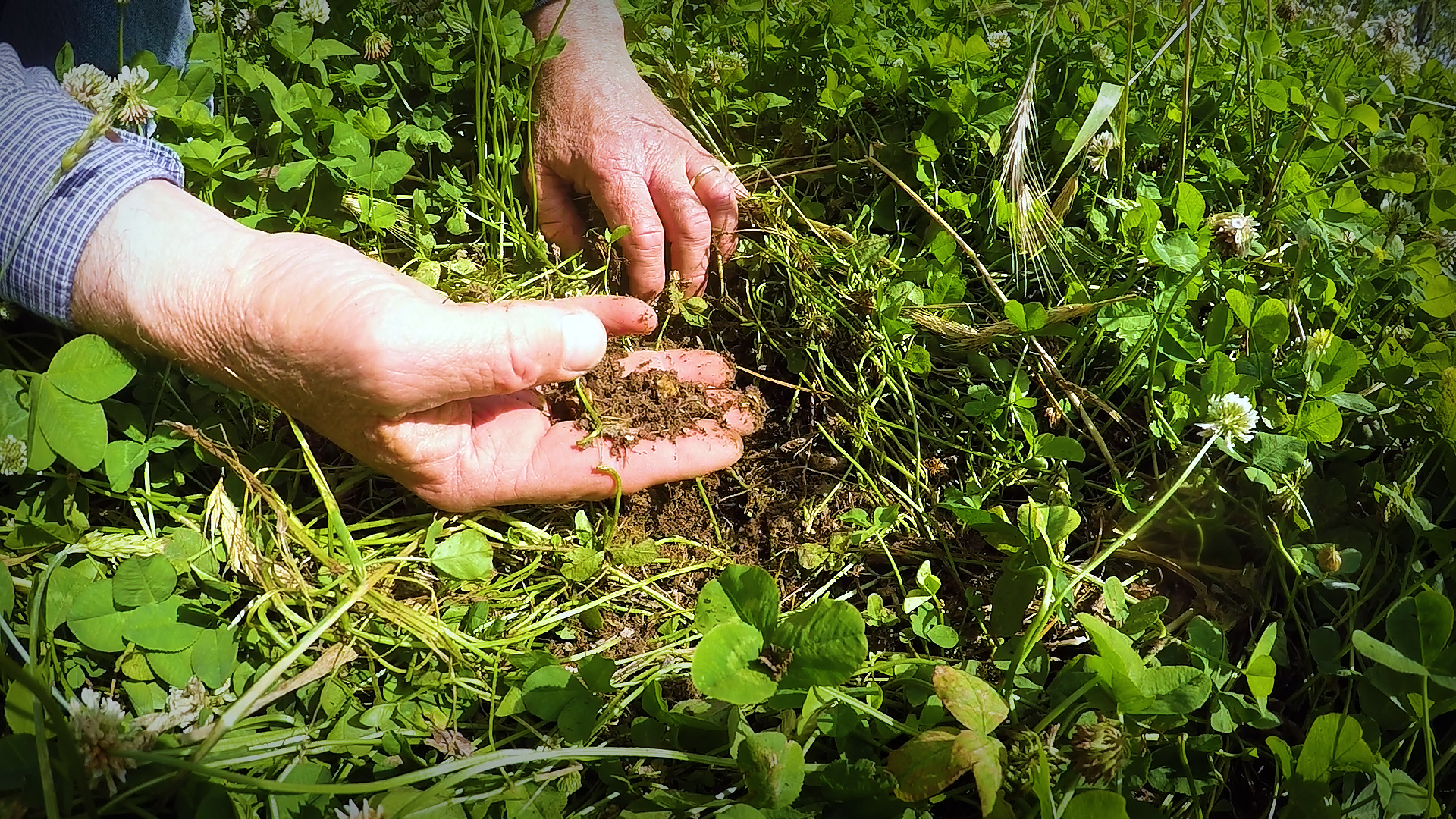
I really enjoy finding sheds. Those shed antlers are specific proof that a buck was using that area. However, finding where a mature buck has been is not the same as being where a mature buck is – within shooting range! Predicting where a mature buck will be during daylight hours and being there at the same time – especially year after year – requires a lot of skill and preparation.
Wonder why so many whitetail hunters go to areas that produce commercial row crops year after year? If you look at a map of the whitetails’ range, the portion of the area that produces commercial row crops is relatively small. Yet, the majority of Boone and Crocket and Pope and Young entries come from areas where commercial crops are produced.
There are two simple reasons and they both relate to flat ground. Flat ground, especially in the Midwest, is almost always better quality soil compared to where the topography is steep and the topsoil has been eroded. However, years and years of producing and harvesting commercial crops have significantly reduced the amount of nutrients and beneficial bacteria in the soil. Without adding fertilizer and beneficial microbes back to the soil, it would not be nearly as productive. These elements are rarely added back to the soil unless it is commercially farmed. Hence they are rarely applied to areas with steep topography.
The Proving Grounds is a perfect example. It has very steep terrain and was extremely eroded from exceedingly poor timber harvest and agricultural practices decades ago. There literally was no topsoil – only rock. I never disc a plot at my place because it would only shuffle rocks around and cause erosion of the limited amount of organic matter that is present.
However, by adding poultry litter that has been composted with beneficial, soil building bacteria added I’ve significantly improved the quality of crops produced in my food plots. I can now grow quality crops, even on the rocky soil where I never disc! Quality forage and grain crops are only nutrient transfer agents. They serve to transfer nutrients from the soil and air (air is roughly 78% nitrogen – capture that and never pay for nitrogen again!) to deer and other plant consumers.
Over the past few years we have been testing different cover crop varieties and planting methods here at The Proving Grounds. We do this to continue learning how we can improve the soil. Food plots are fun to hunt over, but food plots are tools. These tools work to transfer nutrients from the soil to wildlife. Plants take nutrients from the soil and air then produce vegetation that is consumed by wildlife.
Some excellent research (watch episode #296 here) has been published confirming that better soil and nutrition means bigger and healthier deer. So, as you may have guessed by now, cover crops are used to improve your soil! There are many ways that cover crops or, in our plots, Eagle Seed Broadside, improve the soil’s health. Some of the benefits are immediate while others occur over time. Nevertheless, these improvements help to increase the quantity and quality of the nutrients that are available to the plants (watch episode #288 here).
Some plants are better at capturing nutrients and transferring to consumers (deer, cattle, humans) than others. Those plants typically are the crops grown in commercial ag – to feed humans (and deer). Oak trees transfer nutrients – but the vast majority of the nutrients they transfer are tied up in the wood or the structure of the tree.
Soybeans also transfer nutrients but a much higher percentage of the nutrients they transfer from the soil and air are deposited in the soybean leaves and eventually the soybean pods. Deer readily consume soybean leaves and pods. Deer rarely consume the trunks of oak trees – and never express their full antler growth potential when oak leaves and acorns are most of their diet. This is a primary reason bucks of the same age class living where soybeans are commonly grown will have larger antlers compared to bucks living in areas that are primarily forested.
Healthy soil contains essential nutrients and minerals. These elements are taken up by plants through their root systems. Plants transfer those nutrients and minerals to deer that consume them. Our Eagle Seed soybeans are transfer agents for those elements contained in the soil. Poor soil will limit the amount of genetic potential a deer can express. This is why we take soil samples each season to continue improving our soil, ultimately growing larger antlers and healthier deer
Some of you are already yelling “acorns.” Acorns are much lower in nutrient content than soybean leaves or pods – there is no comparison between the nutritional quality of acorns and soybeans – or the antlers produced by bucks that primarily consume either crop.
So, if you want to hunt mature deer that have expressed most of their antler growth potential, you need to hunt where the soil has plenty of nutrients and plants that efficiently transfer those nutrients from the soil and air to deer. This can be in regions were commercial crops are grown (flat land) or where quality food plots are maintained.
For example, there isn’t a commercial soybean or corn field for many miles from my property. However, over the years, I’ve converted the few flat spots among the hills where I live to productive, nutrient-rich food plots. The results have been more than pleasing! My family and I have been blessed to produce and harvest several large, mature bucks.
If your objective is to harvest mature bucks with large antlers, you can go to flat, crop producing ground or grow the same crops where you hunt. Big antlers start in the dirt – and it usually requires well fertilized flat dirt to grow good nutrient transfer agents (crops like soybeans) to allow bucks to produce their best antlers!
Growing Deer together,
Grant
A Big Question For Deer Hunters: How Many Bucks?
The answer to this question has implications for deer hunters that they may or may not want to hear. Why? Because after a lengthy, scientific answer (see below) the bottom line is that to know how many bucks to harvest, hunters will need to spend more time in the woods hunting. Why? You can only know the answer to this question through repeated observations and analysis. Ultimately it may also mean more time in the stand using the best tool that deer hunters have at their disposal: the trigger finger. If you aren’t seeing mature bucks it is time to implement trigger finger deer management.
Deer hunters that want to have the best hunting possible on their hunting ground need to know that reducing stress on the local deer herd is one of the most important factors for better deer hunting and mature, huntable bucks. An equally important herd characteristic that should be managed is the adult sex ratio. The adult sex ratio is calculated very easily: it’s the number of bucks to does that are at least 1.5 years old. For example, if a herd has five bucks and ten does that were 1.5 years old or older, that herd’s adult sex ratio would be 1:2. I consider a buck to doe ratio of 1:1 to be the best for challenging, rewarding hunts. This is a “balanced” ratio for whitetails.
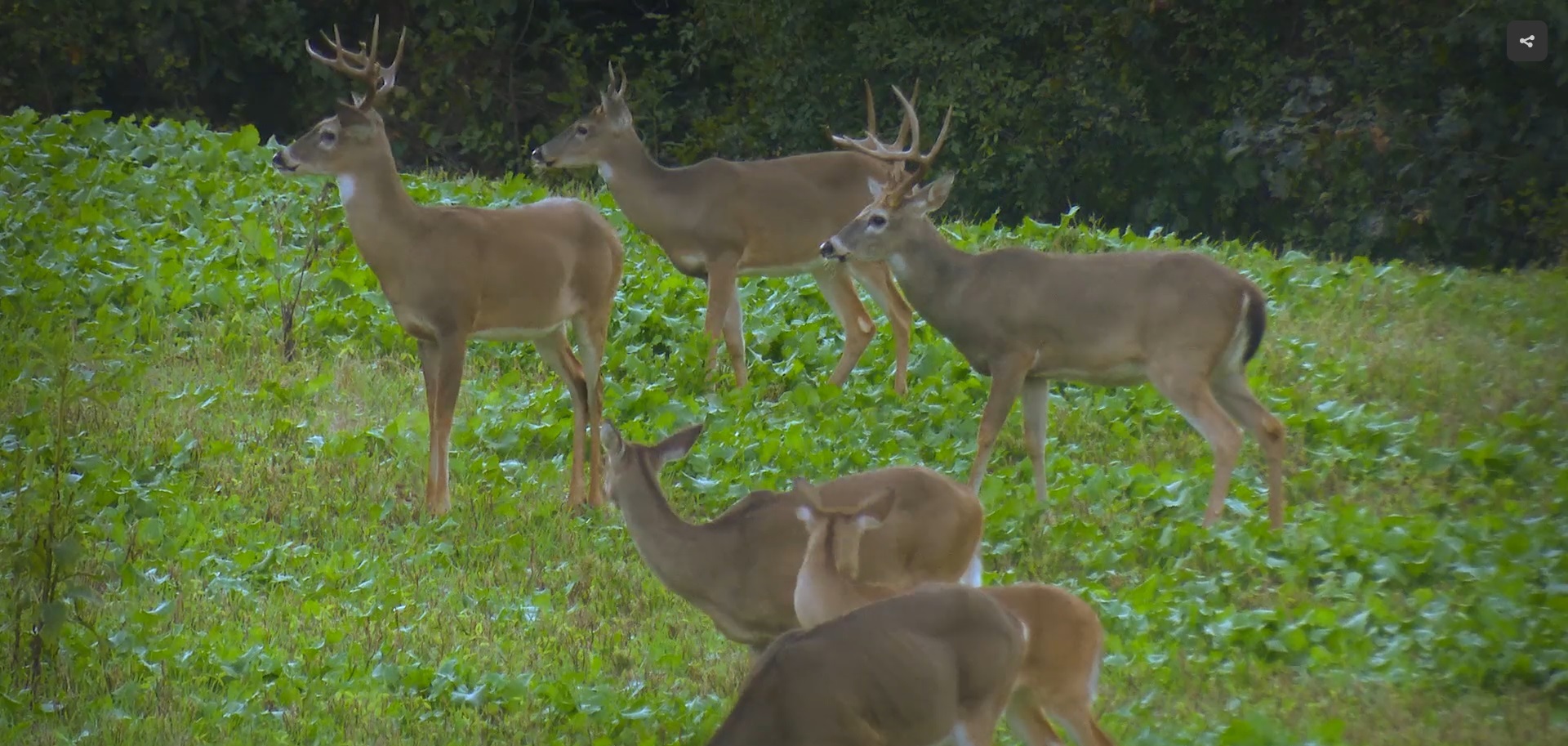
The balanced adult sex ratio has benefits throughout the life of a whitetail. Bucks will often attempt to tend a doe before she is receptive and remain near her for 24-48 hours. While he is tending that doe, other does may also be receptive. In fact, if the herd’s adult sex ratio is skewed heavily toward does, some does may cycle through their receptive period without being bred.
Those does that were not bred during the first cycle become receptive again about a month later. This means she will produce fawns a month later (or more if she cycles multiple times). Fawns that are born later will likely struggle as the conditions for fawning are probably not as favorable: as the summer progresses forage quality tends to decrease, insect loads become higher, the temperatures become higher, etc. Restated, the conditions for prospering as a fawn tend to decline as the summer progresses.
It is more difficult for deer to express their full potential at maturity if they didn’t have all the required resources as a fawn. In addition to providing good quality forage (nutrition) and cover, it is just as important to ensure the adult sex ratio is balanced so the majority of fawns will be born during the optimal time for growth and reduced stress.
The adult sex ratio impacts the herd’s health and huntability, especially for mature bucks. It is very stressful for mature bucks to participate in the rut. It is well documented that captive bucks in relatively small enclosures (less than five acres) with access to all the supplemental feeds they can consume often lose +/- 30% of their body weight during the rut. Given this, imagine the cost of participating in the rut for free-ranging wild bucks. These bucks must search for quality food, be constantly alert for two and four legged predators, and face all the daily challenges that captive deer avoid. In addition to the challenges of surviving, if a buck is part of herd where he is one of the “few” bucks around to breed the available does he will have to work that much harder and longer to breed the does when they are receptive. When the adult sex ratio strongly favors does, the duration (days, weeks or even months) that a buck will seek, chase, and tend does is greatly extended simply because some does will not be bred during their first receptive cycle.
That breeding stress is not limited to mature bucks. Yearling bucks that are not fully mature will seek, chase, and tend receptive does when mature bucks are occupied with other receptive does. The energy that these yearling bucks used for chasing does would be used for developing antlers and body weights. These young bucks would be dissuaded from breeding by the presence of mature bucks (and their pheromones). Immature bucks need a huge amount of resources simply to maintain skeletal and body growth. The resources expended by participating in the rut may well limit the resources available for skeletal and body growth.
The does are also affected by an unbalanced sex ratio. It takes resources for does to cycle through their receptive period multiple times and then nurture a fawn or fawns past the prime fawn rearing season.
Bucks, does, and fawns simply do best when they are born and rut during a natural timeframe and cycle. The best tool to ensure your herd is breeding and fawning at the optimal times is to manage the herd for a balanced adult sex ratio and ensure the population doesn’t exceed the habitat’s ability to supply quality forage.
In addition to a healthier herd, another huge benefit to managing for a balanced adult sex ratio is that that competition for breeding will likely be more intense. Bucks may be more active. Most likely hunting strategies such as calling, rattling, using decoys, etc. may be more effective than in herds where there is not as much competition during the rut.
A great tool to manage your land to yield mature, huntable bucks is to establish and maintain a herd with a balanced adult sex ratio. Trigger finger deer management is essential to balance the ratio. Does will most likely need to be harvested. Hunters seeking to balance the adult sex ratio on their hunting grounds will have a longer, more challenging hunting season. It also means more free range meat for the freezer or meat to share with friends and family!
Growing Deer together,
Grant
Second Rule For Managing Deer And Growing Big Bucks
Last week I shared the importance of allowing bucks to mature so they can express their antler growth potential (read The First Rule Of Deer Management here). By allowing more bucks to mature, there will be more bucks in the area which usually equates to better hunting.
However, there are lots of areas with a relatively high density of mature bucks, but very few bucks with good antler development. Where does this occur? It is often in areas where no habitat management activities occur. For bucks to express their genetic antler development potential, they must:
- be allowed to mature
- have access to quality forage throughout the year
Big bucks are usually seen where the combines roam. Soybean country. Compare the following maps.
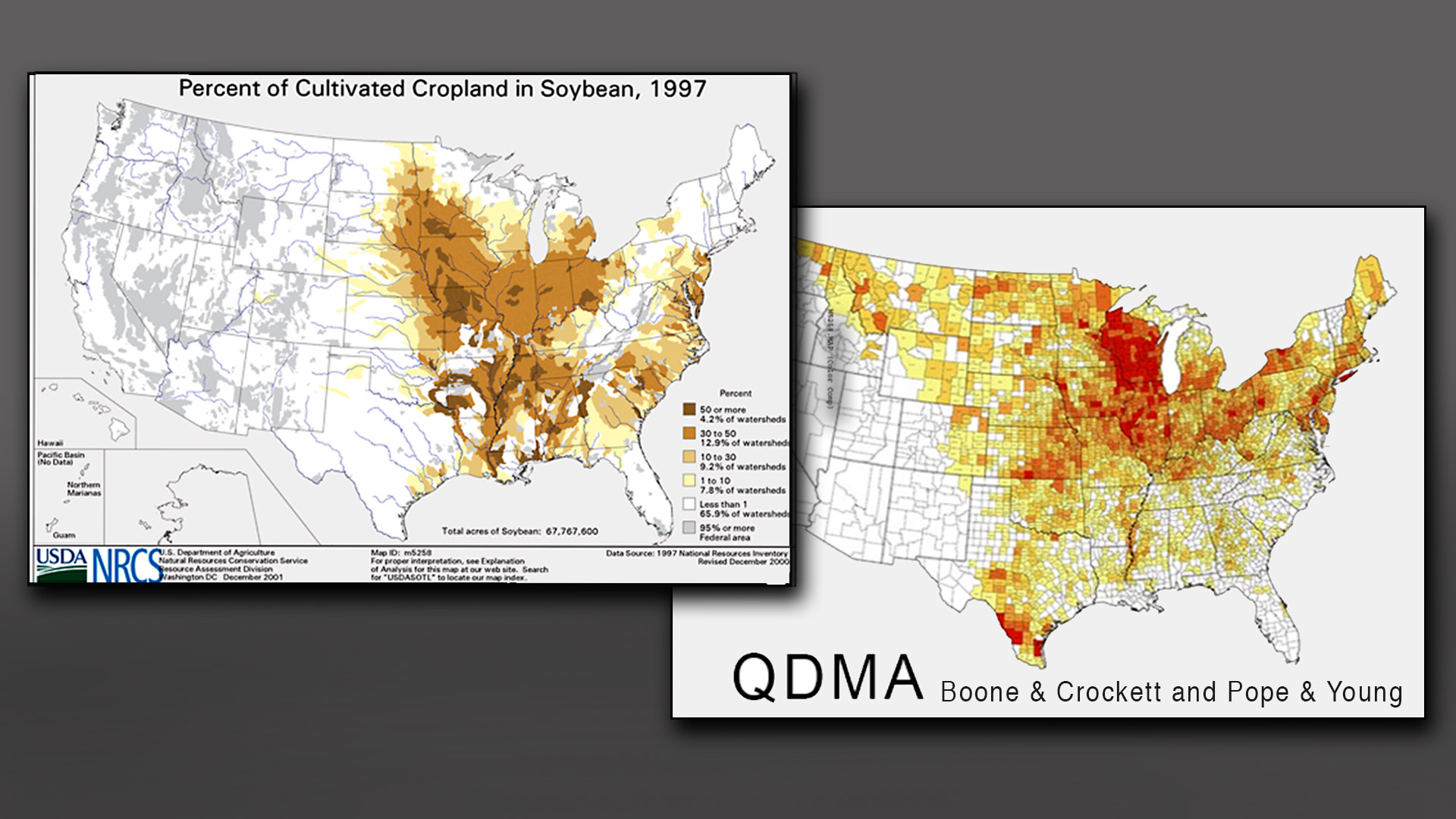
The first shows the distribution of soybeans grown throughout the US and the second shows the distribution of Boone & Crockett and Pope & Young bucks harvested. The correlation is not perfect, but it’s close enough to make the point.
The good news is that soil can be improved anywhere – even if the land you hunt is not shaded on the soybean map. Notice that it’s a long way to any color on the map from where I live (Stone and Taney counties, MO). Even so, I grow great soybeans during the summer and cool season crops during hunting season. This combination has produced some great bucks on my mountainous, rocky property.
Good forage serves two purposes:
- allowing deer to express their potential
- serving as an attractant so mature bucks can be patterned
Ensuring quality forage is available year round is #2 on my top 10 list of managing land to yield mature, huntable bucks.
Growing Deer together,
Grant
The First Rule Of Deer Management
It’s important to consider how to make a property “huntable” or hunter friendly for mature bucks. For a property to be huntable for mature bucks there are several factors that must be considered.
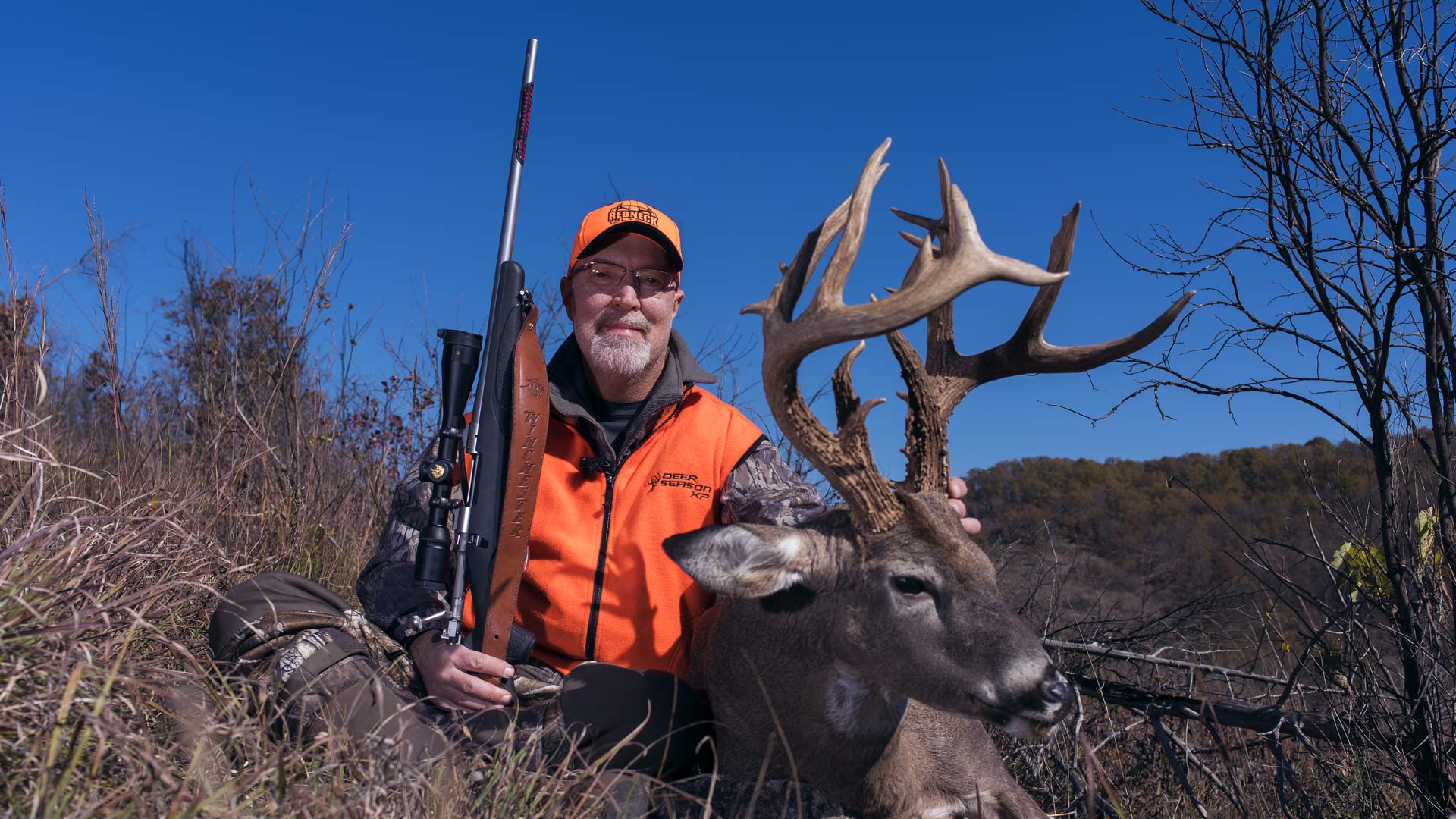
Have realistic expectations. This is the first step to hunting satisfaction. It is important to understand that having huntable, mature bucks doesn’t mean there will be a Boone & Crockett class buck behind every tree. A buck is mature to me when they are four years old or older. This is because most of their skeletal development is complete and they can use most of their excess resources to produce bigger antlers. Few free-ranging bucks express their genetic potential due to limitations in habitat quality.
Have more mature bucks. To get more mature bucks, immature bucks must be passed and allowed to grow. Dead deer don’t grow. It sounds simple, but some hunters still don’t understand. They harvest a good looking two year old buck and then complain that they never harvest a “monster buck.” They’ve probably harvested several monster bucks. They just shot them before they matured and produced large antlers!
Bucks typically produce larger antlers as they age. Research shows that two and three year old bucks produce, on average, about 50 and 75% of their antler growth potential. It’s not until bucks mature to four years old or older that they express, on average, about 94% of their antler growth potential. To have an opportunity to harvest mature bucks, you must hunt where bucks are allowed to mature. The more bucks that are allowed to live to 4+ years of age, the easier it will be to harvest a mature buck.
Trigger finger management is the least expensive form of deer management. It simply costs less to pass immature bucks than any other form of management for establishing a hunter friendly population of mature bucks.
If you want to tag a mature buck, be prepared to pass immature bucks. Yes, others in your area may kill immature bucks. But, the trend must start somewhere and it is most likely to start with you. Share the education with other hunters in your area. You don’t have to convince all of them, but you won’t convince any of them when gathered around an immature buck you just harvested.
Remember, the first rule of deer management, “Dead Deer Don’t Grow.”
Enjoy Creation,
Grant
Maximize The Growing Season!
Sadly, Missouri’s turkey season recently ended. However, we feel much better knowing antlers are growing and fawns are dropping! Before long, it will be deer season. With deer season in sight, it’s important that all of our Trophy Rock stations are refreshed and ready for the upcoming growing season.
We keep many of our Trophy Rock sites out all year. Why? Because deer need minerals all year. We want does to be healthy in the winter when fawns are only a few weeks into development. We want to help bucks make it through the rut and the harsh winter conditions. However, deer tend to require larger amounts of mineral during the antler development, fawning and milk producing season (late spring and summer). During this time, it is especially important that all our Trophy Rock stations are full and there is plenty of mineral available to deer.
We prefer Trophy Rock because it has 60+ natural micro and macro nutrients! Deer may only need very small amounts of some of these minerals. However, if these trace minerals are not available to deer, it can keep bucks, does, and fawns from reaching their potential. If you want your deer herd to be healthy and reach their maximum potential this growing season, Trophy Rock is a great start!
I hope you are able to get Trophy Rock out on your property and begin monitoring the results with trail cameras. It won’t be long before it’s time to pattern deer and create the 2017 hit list.
Enjoying Creation,
Daniel
3 Hunts = 4 Does Down – Episode #374
New Video
Ever wonder how to pattern and hunt late season deer? Watch how management, strategy, and trail cameras come together for late season success!
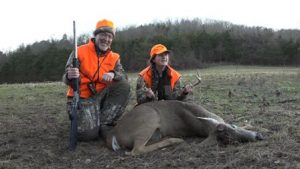 Short Clip:
Short Clip:
Ever walked up to a deer and been shocked at what you find? Watch more behind the scenes video from Rae’s recent hunt that ended with a big surprise!
New Weekly Blog:
Did deer not eat from your newer food plots? Find out what may be the cause and why you should try again this year.
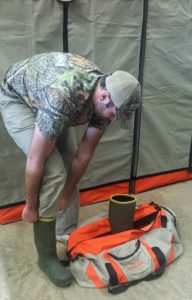
Tip of the Week:
Storing your trapping boots in a Scent Crusher Ozone Gear Bag can help reduce human scent at the trap site.
Kentucky Hit List Buck Down! – Episode #369
New Video
Watch as Daniel from Oklahoma joins the Kentucky crew. He has to pay the “dues” before having the opportunity to tag one of their hit list bucks! Plus, enjoy the excitement as young Trace Harker pulls the hammer on an Ozark Mountain country buck.
 Short Clip:
Short Clip:
Pops talks at the skinning shed about his hunt! Check it out as he tells the story only as Pops can!
New Weekly Blog: Trigger Finger Management
Check out Daniel’s blog about one of the primary reasons we had such a successful season at The Proving Grounds.
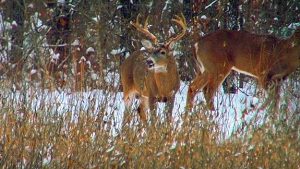 Tip of the Week:
Tip of the Week:
Get ready – cold and snow will drive deer to food plots!



